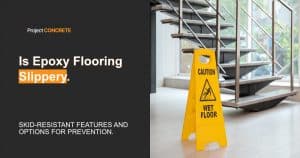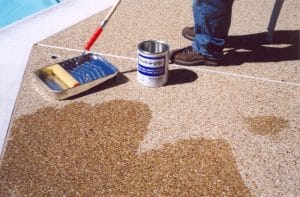
While durable and sleek, epoxy can be slippery under specific conditions such as wetness or grease. In this insightful guide, we’ll examine when the topic of “is epoxy flooring slippery?” and discuss when it might pose a slip risk and share tips on how to ensure your surface is a non-slip surface.
Understanding Epoxy Flooring
Epoxy flooring, a robust and adaptable flooring solution, is composed of resin and hardeners mixed together. It’s a fitting choice for a range of environments, from cosy homes to bustling commercial areas and even industrial sites that must comply with stringent safety standards.
In terms of practicality, epoxy flooring offers significant benefits. It is exceptionally durable, with a lifespan ranging from 10 to 20 years. Its resilience, combined with low maintenance requirements, makes it particularly suitable for high-traffic areas.

Epoxy Floor Solutions And Slipping
The perception that epoxy floors are inherently slippery is not entirely accurate. While epoxy flooring can become a slipping hazard in certain conditions, this risk is influenced by several factors.
- Moisture and Contaminants: Epoxy’s non-porous nature means it doesn’t allow water to disperse, which can create a slipping hazard when the floor encounters moisture, liquids, or other contaminants like grease or soap residue.
- Surface Finish: High-gloss finishes, such as those found in metallic epoxy, may enhance the floor’s aesthetic appeal but can also increase slipperiness, particularly in wet conditions.
- Impact of Dust and Scratches: Dust accumulation and surface scratches on epoxy flooring can alter its traction. This can lead to either increased slippage or, in some cases, provide a minimal extra grip.
In essence, slipperiness on smooth surfaces is not an inherent characteristic of epoxy flooring; rather, it is contingent on external factors such as the presence of spills or dampness.

How to Enhance Epoxy Flooring Slip Resistance
There are various methods available to enhance epoxy flooring slip resistance. These include incorporating additives designed specifically for anti-slip properties and applying specialized coatings. Proper maintenance and cleaning techniques also play an important role in addressing this issue.
To elaborate, the additives used to improve slip resistance can range from fine to coarse aggregates, which are intermixed into the epoxy before it sets. This creates a textured surface that provides better grip underfoot. Some of these additives, like micronized polymer beads, are virtually invisible once applied, maintaining the floor’s aesthetic while improving safety.
Specialized coatings, on the other hand, can be applied as a final layer over the epoxy. These coatings contain elements that increase friction and thus reduce the potential for slipping. They can be clear or pigmented, depending on the desired look, and coat them are available in various finishes from matte to glossy, allowing for customisation of the space.
Regular cleaning and maintenance are critical in preserving the non-slip properties of epoxy floors. It’s important to promptly clean up spills and remove any debris, as these can create slip hazards. Specialized cleaning products and equipment designed for epoxy floors can also help maintain the floor’s texture and slip resistance over time.
For the best results with epoxy garage floors the combination of additive incorporation, specialized coatings, and diligent maintenance is optimal. By using all of these in together the slip resistance of epoxy floors can be significantly enhanced, making them safer for all users while still delivering the durability and visual appeal that epoxy is known for.

Anti-Slip Additives
The incorporation of anti-slip additives is crucial for enhancing the slip resistance of epoxy floors. Popular options include clean silica sand, aluminum oxide, and polymer-based grit like Shark Grip. These can be added to the epoxy coating before or broadcasted over it while still wet in order to improve floor traction.
While adding aluminum oxide creates a strong and rough surface that is suitable for industrial environments, it may make cleaning more difficult due to its texture. On the other hand, using an additive specifically designed for use on epoxy floors helps reduce slipperiness by providing both a non-slip coating and fine texture which also reduces glossiness.
Coatings and Surface Treatments
To additives, there are specialized coatings and surface treatments available for epoxy floors that can enhance their slip resistance. These options can be tailored specifically for different industries in order to ensure safety in high-risk areas.
Different levels of slip-resistant grades exist for these types of floor coatings, allowing customization according to specific indoor and outdoor needs. By incorporating elements like sand, glass or aluminum oxide into the coating formula, a higher level of skid resistance can be achieved.
Proper Maintenance and Cleaning
Maintaining and cleaning epoxy floors is essential to keep their anti-slip features effective. Here’s a guide to ensure their safety and longevity:
- Dust mop the floors regularly with a microfiber pad to collect fine particles.
- Rinse the floors with water or a hose to wash away any accumulated substances.
- Use a squeegee to remove any excess water and debris from the floor.
For a safe and effective clean, opt for a diluted ammonia solution or phosphate-free cleaners specifically designed for epoxy floors, rather than harsher cleaners like citrus-based products, vinegar, or soap solutions, which can increase the floor’s slipperiness and reduce its shine.
Don’t let these cleaners sit on the floor for too long—around one minute is sufficient.
Deep cleaning sessions should be conducted every three to four months, particularly in high-traffic areas, to prevent grime and dirt buildup and maintain consistent hygiene levels. Be mindful that oil and certain substances can leave behind marks, so it’s best to clean spills quickly and thoroughly.
Consistent care using the right techniques is crucial for preserving the non-slip and aesthetic qualities of epoxy floors. When cleaning, it’s important to avoid chemicals that can diminish the floor’s resistance, and opt for a safe cleaning product.
Best Solutions To Make Epoxy Flooring Less Slippery
Here are the best solutions for making epoxy garage floors less slippery:
- Shark Grip: An easy-to-use anti-slip additive for epoxy paint that provides non-slip coating and fine texturing while reducing gloss. Suitable for most stains and paints, it’s comfortable for bare feet and ensures a safer surface. However, it’s less effective on thicker final coats where the beads may sink.
- Aluminum Oxide Additive: Ideal for industrial settings requiring maximum grip, this additive is mixed with water-based urethane finishes. While highly effective, its coarse texture can be rough on bare feet and challenging to clean.
- Silica Sand: Added to the final floor coating, silica sand creates a bumpy, less slippery surface. It’s visible under a clear coat, so a coloured top coat is recommended. However, it can form cracks and break down under heavy foot traffic.
- SparkleTuff™: This anti-slip floor coating is applied over epoxy floors, offering excellent wear, chemical, and weather resistance. It’s highly slip-resistant, easy to apply and clean, and suitable for a wide range of surfaces, including underwater applications.
- Anti-Slip Grit in Single Coat Epoxy: Adding anti-slip grit to the final coat of epoxy creates a surface that is both comfortable for bare feet and slip-resistant. This is a straightforward solution for enhancing safety in slippery conditions.
- Containment Mats: Particularly useful in snowy climates, these mats absorb water, road salts, and snow, preventing slipperiness. They can be hung up to dry and are a temporary solution requiring multiple sets for continuous use.
- Indoor/Outdoor Carpet Runners: These carpets are available in various sizes and colours, offering an attractive and less slippery surface for your garage. They are stain-resistant, easy to clean, and can be alternated with synthetic rubbers and PVC vinyl in wet conditions.
Common Misconceptions About Epoxy Flooring Slipperiness
Many people have misunderstandings about the use of additives in epoxy flooring, which can lead to misconceptions. One commonly misunderstood additive is aluminum oxide, known for enhancing slip resistance but also criticized for being difficult to clean and feeling coarse. It’s important to note that these concerns do not make the epoxy floors slippery surface inherently slippery. The level of perceived slipperiness on an epoxy floor depends more on external factors than on the flooring itself.
Proper maintenance and choosing appropriate additives and coatings are crucial aspects when considering safety measures for your epoxy floor. Additives like aluminum oxide certainly contribute to improving its slip resistance, but they should not be seen as a sole solution without proper care taken into account. With careful attention paid towards upkeep and utilizing suitable additives or coatings tailored specifically for your needs, you can significantly reduce any risks of slips or falls associated with this type of flooring.

Tips for Preventing Accidents on Epoxy Floors
Preventing accidents on epoxy floors can be achieved through various practical solutions. One effective solution is placing synthetic rubber or PVC vinyl mats to address slippery surfaces and wet conditions quickly.
Apart from using mats, carpet runners are also an excellent garage flooring option for reducing slipperiness on epoxy floors while adding aesthetic appeal. They are low maintenance and easy to clean, making them a convenient choice. Bordering high-moisture areas with synthetic or vinyl runners helps keep these spots less slippery.
While there are many cost-effective remedies available, the most efficient way to prevent slips and falls is by maintaining dryness on all parts of the epoxy floor at all times. It’s crucial to promptly clean up any liquid spills that may occur as this plays a significant role in creating a safe non-slip environment for bare feet.
Summary
We have now answered the question is s epoxy flooring slippery! Epoxy flooring, a specialty of Project Concrete, offers a blend of durability, design flexibility, and safety. While slipperiness can be a concern, it’s easily mitigated with the right additives, coatings, and regular maintenance. Understanding the unique properties of epoxy and selecting the ideal type for your space ensures both beauty and functionality.
Project Concrete is dedicated to transforming your spaces, be it a garage, kitchen, or industrial area, into stylish yet sturdy environments. Our epoxy flooring solutions promise not only aesthetic appeal but also exceptional durability and enhanced safety against slips. Choose Project Concrete for epoxy flooring that perfectly balances beauty, strength, and safety. Let us elevate your space with our expert solutions – contact us today for durable and safe epoxy flooring tailored to your needs.
